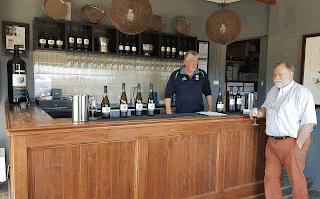As evidence that I can still do this in some parts of Australia, here is a relatively recent picture of myself at Granite Hills winery, in Victoria, with Llew Knight the proprietor / winemaker. (I can highly recommend the wines.)
Another common way of selling direct-to-customer wines (in a country with a Three-Tier System, requiring a middleman for distribution, like the USA) is a winery club, which in many cases is built up from people visiting the winery, in the first place. It has been suggested, however, that the average length of club membership is not necessarily all that much (The tough questions wine clubs face).
So, my modern question is about the charging of a fee for visiting a winery. The recent Silicon Valley Bank 2025 Direct-to-Consumer Wine Report tackles this topic on pages 38—49, with regard to the USA. I will look at a few of the take-home messages here.
The basic reason for charging tasting fees is that after the 1980s:
“Tasting fees were first levied to discourage tasters who treated wineries like
their local pub. Charging tasting fees proved effective in discouraging those
who were taking advantage of the winery’s generosity and diminishing the
experience for others.”
their local pub. Charging tasting fees proved effective in discouraging those
who were taking advantage of the winery’s generosity and diminishing the
experience for others.”
The fees currently being charged in the USA are pretty steep, as shown in the next two graphs, for different years and then different regions.
That is a pretty continual increase over the years. Tasting fees seem now to be an essential part of a winery’s revenue model, rather than merely offsetting the cost of the wine poured (as it was, originally). Clearly, some regions are also doing much better than are others.
When asked: “In what circumstances do you waive tasting fees?” the US winery responses were:
for joining a wine club (the most common option)
for purchasing a specific number of bottles
for purchasing a specific dollar amount
no reimbursement (14% in both 2023 and 2024).
Clearly, given current economic circumstances, we can also ask: “Has your winery reduced tasting room fees to improve visitation?” Answer: very few. For those who have done so, we can then ask: “If your winery lowered tasting room fees, has it improved visitation?” Answer: for about one-third it has improved, and one-third it has stabilized.
We will not, of course, ever see a return to “my day”. However, to return to my original point, this final graph shows just which US winery regions do manage to get some wine purchases from their visitors, and how much. Napa is currently doing very well for itself.
That is a pretty continual increase over the years. Tasting fees seem now to be an essential part of a winery’s revenue model, rather than merely offsetting the cost of the wine poured (as it was, originally). Clearly, some regions are also doing much better than are others.
When asked: “In what circumstances do you waive tasting fees?” the US winery responses were:
for joining a wine club (the most common option)
for purchasing a specific number of bottles
for purchasing a specific dollar amount
no reimbursement (14% in both 2023 and 2024).
Clearly, given current economic circumstances, we can also ask: “Has your winery reduced tasting room fees to improve visitation?” Answer: very few. For those who have done so, we can then ask: “If your winery lowered tasting room fees, has it improved visitation?” Answer: for about one-third it has improved, and one-third it has stabilized.
We will not, of course, ever see a return to “my day”. However, to return to my original point, this final graph shows just which US winery regions do manage to get some wine purchases from their visitors, and how much. Napa is currently doing very well for itself.





This is an interesting question, in particular for someone who visits or organises perhaps some 2000 tasting room visits per year.
ReplyDeleteIn the US, Napa is quite an outlier with exceptionally high tasting room fees. Perhaps not surprising, being close to "rich" San Francisco.
I think the US is also quite different from many other wine countries so one should perhaps be careful with conclusions.
But in any case, the SVB analysis is really interesting. In some ways it is worrying, it shows a trend towards moving wine more and more towards a beverage for the rich (perhaps it is already - in particular in the US).
If I may, you may be interested in this longer analysis that I did of the SVB report last year, with a particular focus on Napa: https://www.bkwinetours.com/travelog/napa-valley-pricing-itself-out/